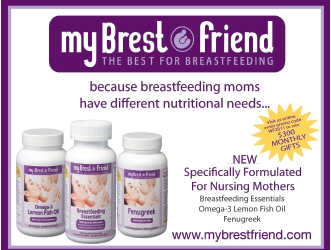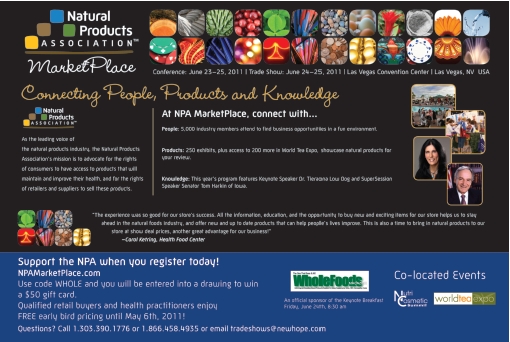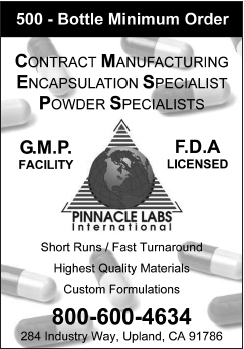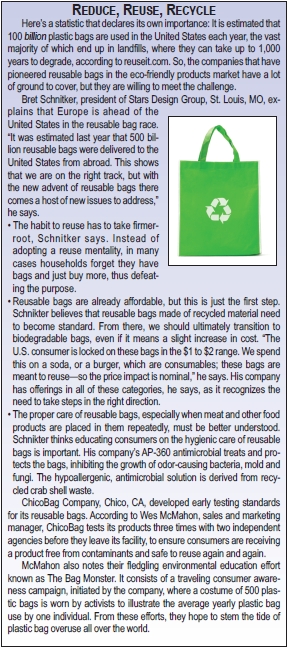Self-interest can be a driving factor behind the success of eco-friendly household products. That’s because beyond the sustainable, earth-friendly ideals they represent, the products in this segment also serve to address issues of personal health.
In some settings, according to reports alluded to by Shanna Redkey, marketing director for Greenology Products, Raleigh, NC, the quality of the air we breathe indoors is up to 2–5 times worse than outdoor air, and sometimes up to 100 times worse (1). “This creates potentially alarming exposures in our homes, schools and work environments,” she says. The correlation is constantly being made between cleaning chemicals and cancer, autoimmune disorders, reproductive and other health issues. “Consumers are becoming more sensitive to these facts, albeit too slowly for most of us in the green movement,” Redkey says.
The other side of the equation for consumers is a basic, long-term concern over the environment. Whether it is water usage, waste, global warming or toxic pollution, a larger percentage of people now identify themselves as green-minded. A 2009 press release by the International Housewares Association stated that more than half of surveyed consumers consider themselves at least very interested in environmentally friendly products. 
The market presence of eco-friendly products will not lag behind. In fact, it is on its way to jumping by a factor of 10 quite soon, according to a Mintel study. “Eco-friendly household cleaners counted for only 3% of the cleaners on the market in 2008, compared to 30% today,” says J.R. Rigley, vice president of sales and marketing for J.R. Watkins Naturals, Winona, MN.
Home Ecology
There are so many environmental issues for eco-friendly home care and cleaning products to confront that it may seem a staggering and futile effort for some consumers. Retailers can step up to reinforce the importance of these products. Larry Plesent, CEO of Vermont Soap, Middlebury, VT, argues that change comes with time and under the right circumstances, albeit very gradually. “It is important to realize that green is a process, not a result. Our civilization is not going to ‘go green’ over night,” he says.
The current scrutiny all products are facing is in the usage phase, explains Wes McMahon, sales and marketing manager for ChicoBag Company, Chico, CA. “Consumers are concerned with the health and safety of their families and often question commonly known threats such as BPA (in plastics), lead (in paint) and toxic chemicals and ingredients (in household products),” he says. In the near future, McMahon predicts there will be a shift of focus toward the production phase of products, and the potentially toxic inputs involved. Testing for heavy metals other than lead, like cadmium and mercury, will likely become standard procedure due to public pressure.
 A major environmental concern of which many consumers are increasingly aware, and with which all product makers must contend, is water usage. Amid rising costs and dwindling resources, Cindy Rimer, vice president of sales and marketing for Biokleen, Vancouver, WA, explains that eco-conscious manufacturers are taking account of their water and energy use. “Cleaning products, even eco-friendly ones, can contain more water than active ingredients and the manufacturing process involving water can result in waste and inefficiencies,” she says.
A major environmental concern of which many consumers are increasingly aware, and with which all product makers must contend, is water usage. Amid rising costs and dwindling resources, Cindy Rimer, vice president of sales and marketing for Biokleen, Vancouver, WA, explains that eco-conscious manufacturers are taking account of their water and energy use. “Cleaning products, even eco-friendly ones, can contain more water than active ingredients and the manufacturing process involving water can result in waste and inefficiencies,” she says.
There are several water and energy conservation programs that manufacturers can put in place. These include, Rimer says, a rinse and reuse system that does not allow waste water to be dumped after its initial use in manufacturing. Companies can formulate products to be processed with cold water instead of warm, meaning less energy is required.
In terms of the products themselves, some companies also feature cleaners with concentrated solutions, thus saving more water than some conventional products. Additionally, water and energy used in manufacturing can be offset through the purchase of energy and water conservation certificates purchased from various environmental organizations. 
For its part, Rimer says her company is dedicated to replacing hazardous elements with eco-friendly ones in cleaners of all kinds, from consumer carpet products to industrial strength solutions. Toward this end, the company works with the Environmental Protection Agency on its Design for the Environment (DfE) program, which certifies eco-friendly products.
A less wet, but equally troubling, environmental concern is paper waste. “When we’re wasting paper towels and toilet paper, we are wasting natural resources, promoting the use of harmful chemicals and using up valuable energy,” says David Patrick, owner of Roll it Rite, Cape Girardeau, MO. He also points out that the excessive disposal of paper can pollute waterways.
With a capacity to rapidly stuff landfills and to compel the destruction of forests, overuse of paper is rampant, but it can also be remedied with the right products. Roll It Rite is one such paper waste-reducing product. A foam insert slips into a standard toilet paper or paper towel tube, and serves to reduce waste by slowing the rate that paper is dispensed.
 The product can, according to Patrick, reduce household paper consumption by 50% or more. On top of the trees that their widespread use could save, paper conserving products can also lead to consumer savings. In general, any eco-friendly product that can provide some economic incentive to consumers should have a chance to flourish. “In times of economic uncertainty consumers are very budget conscious and are looking for creative ways to spend less money,” says Patrick, adding that eco-friendly products let them feel good about their purchases, as well.
The product can, according to Patrick, reduce household paper consumption by 50% or more. On top of the trees that their widespread use could save, paper conserving products can also lead to consumer savings. In general, any eco-friendly product that can provide some economic incentive to consumers should have a chance to flourish. “In times of economic uncertainty consumers are very budget conscious and are looking for creative ways to spend less money,” says Patrick, adding that eco-friendly products let them feel good about their purchases, as well.
For Plesent, product quality, price point and innovation are what lead to success in this category. Filling niches will enable some brands to survive longterm because eco-conscious consumers have the same product needs as the rest of the population. For instance, he says that his company created the first certified organic shower gel, pet shampoo, spray cleaner and foaming hand soap.
Product effectiveness. A longstanding notion about “green” cleaning and other homecare products is that they aren’t as effective as their conventional counterparts, or are otherwise lacking somehow, in performance or function. Consumers purchasing these products, then, would be a trade off, sacrificing quality for conscience. To a certain extent, some insiders say, this used to be true, but it is mostly a myth, and advances in technology and product formulation have largely erased any performance gap that might have formerly existed.
Since eco-friendly products have fared well recently, they must do the job well, because everyone agrees that the consumer will not make a repeat purchase of a sub-par item. Redkey says her company understands this reality, so for its products, it starts with performance criteria from the outset, and then looks for materials that will meet those standards in the most organic and sustainable way possible. Rigley says his company is constantly on the look-out for natural ingredients that are both Natural Products Association (NPA)-approved and cost effective at the same time.
There are simply certain things that your clients won’t be willing to sacrifice (well, at least most of them) for the sake of green. “Consumers don’t want to pay for something that doesn’t clean,” says Rimer. She cites the improvement of chemistry techniques as a factor in the continued improvement of green products. This gives manufacturers more options when formulating.
Cutting corners doesn’t work, according to Rimer, because some less expensive options also lead to less effective products. So, the value of using higher quality ingredients that also retain a good environmental profile is self-evident. “You don’t have to sacrifice quality for performance to save a few cents,” Rimer says.
Eco-neglect. Of course, as we all know, not everything masquerading as green these days really lives up to the name, and there are also companies with good intentions that manage to overlook important aspects of environmentalism.
Redkey thinks one area of general focus should be packaging. She points to the standard clamshell-style packaging as a serious offender. Environmentally speaking, plastics are usually less desirable than paper when it comes to packaging. But this material in particular is not typically recyclable, she says, and may also pose a health hazard for children through exposure to sharp package fragments. According to Redkey, it should be done away with and replaced with chipboard or other recyclable packaging. Electronic Article Surveillance (EAS) tags could be used, she says, for products that carry a risk of theft.
While eco-conscious companies may only use sustainable and environmentally friendly ingredients in their products, they may be overlooking other areas that can impact the environment and even the products themselves. “Some processes used to extract the oils from natural ingredients actually use chemicals that are not eco-friendly in order to obtain a higher oil concentration,” says Rigley. Truly eco-conscious companies, he feels, will be out to ensure that the extraction and the rest of the manufacturing process are in line with the ideals behind eco-friendly ingredients.
Rimer says that during hard times, it can become easy for companies to cut their products with more water and other fillers, in order to save in the short term. This practice, of course, results in long-term waste and the environment suffers. There are also companies, she says, who use the practice of coloring their products green or orange to market them as “green” or “natural.”
Greenwashing like this, according to Rimer, has created a lot of consumer confusion, so people are looking for reliable product certifications to sort things out in the near future. Since eco-conscious consumers care not only about what’s in a product but also about who’s selling it, the clutter in green marketing must be cleared up and more transparency will have to be achieved if consumers are to get what they are looking for. According to Rimer, though many care about the values and intentions of the corporations they buy from, the flurry of brands being sold to large corporations makes it hard to determine who’s selling what.
Bret Schnitker, president of Stars Design Group, St. Louis, MO, which owns and manufactures the AP-360 antimicrobial treatment and Green Diamond Bags, says that eco-friendly companies face more hurdles than mainstream ones, and they are not perfect. “Oversight and intent is very important for these groups, but recognition and support is also important. They are not only responsible for being profitable, but also for helping our future.”
Know Your Labels
Plesent points out that whereas today we are awash in green certifications and packaging labels, 15 years ago there were hardly any such certifications in existence, and this has, in his words, befuddled the consumer. To make matters more complicated, a few companies attempt to “self-certify” their products, sticking official-looking labels on product packaging that do not represent any third-party analysis.
By Patrick’s count, there are over 300 third-party environmental seals in existence today. Schnitker lists certifications from the EPA, Bluesign, Cradle to Cradle, DfE, Green Safe, Green Seal and Oeko-tex for some examples of successful programs. But, what can all of these logos on the corner of a carpet cleaner label mean to the average consumer? They may know that they are meant to indicate an eco-friendly product, but what sort of value should they assign to it?
Rigley maintains that third-party organizations need to promote themselves more, educating manufacturers and consumers alike about their mission and their particular standards. “At the same time, brands that carry the logos and seals from these third parties need to aggressively promote the significance of certification,” he adds.
According to Cara Welch, Ph.D., vice president of scientific and regulatory affairs for NPA, the difficult part will be sifting through the less-than-legitimate claims. But she thinks that consumers have grown fairly skeptical, especially when a particular label is obviously not from a third-party organization. In this, she thinks the legitimate labels, such as the NPA’s natural seal, the EPA’s DfE and others, have a definite leg up.
Still, a simplified, well-recognized set of indicators about a product’s eco-status would go a long way toward better serving the consumer and the environment, Redkey believes. Without seeing these indicators on a product, consumers would learn not to trust any greenwashing claims that might be present. The Federal Trade Commission’s “verifiable claims” guidelines, present in the recently updated “Green Guides,” are an excellent start, says Redkey.
A more uniform standard would indeed be ideal to cut through all the noise, says Rimer. Part of the onus is on eco-conscious consumers, who need continue to educate themselves about environmental certifications. If a retailer or consumer is unsure about an ingredient, she suggests, call the company and ask them about it directly. Rimer cautions companies on the future of green marketing, which will consist of more ingredient lists and less-direct green messages on labels, as the FTC has proposed. FTC, she points out, is also recommending that companies stay away from unqualified product certifications.
Though not directly associated with the green movement and not an eco-label, Redkey contends that the U.S. Department of Agriculture’s organic label is as good as it gets in terms of consumer recognition and standards. “There really is no other standard in the industry that is as widely all-encompassing as the USDA’s National Organic Program. They are leaps and bounds ahead of other federal agencies,” she says.
Since the standards for this certification overlap greatly with many environmental and especially health concerns, she deems it an eco-label. She calls it the most widely recognized of all eco-labels, as it is already familiar to many consumers.
Natural partners. Similar to organic, natural standards and environmentalism make good bedfellows. The word “natural” itself is not regulated for use in marketing, and some fear it has lost some of its resonance with consumers. Redkey explains that some newer eco-friendly product makers have been failing, in particular those that have arrived on the market in the last two or three years trumpeting their products as natural. While she says organic is still a solid performer, the term natural may have lost some of its ability to attract consumers.
The NPA and its certification programs aim to represent the natural standard in its purest form. A recent extension of that mission was the creation of the NPA Standard and Certification for Home Care Products, launched last year. Welch says that as a standards organization for natural ingredients, the next logical step after introducing their personal care products standard was into the arena of cleaning products.
Welch says that at NPA, green as a concept is viewed as beyond their scope, since it includes not only the life of a product from the cradle to the grave, but back around to the cradle again (i.e., recycling). She emphasizes that the Home Care standard is only concerned with making sure a product exclusively contains naturally sourced and processed ingredients.
“Those are both areas that are just so deeply entrenched into eco-friendly as a whole,” she says of sourcing and processing. The NPA Home Care division has been in talks with the DfE team at EPA, according to Welch, to see if any joint work can be done. Welch says it is interesting how the two programs align and how they differ. She says eco-standards like DfE emphasize the way ingredients break down in the environment and whether they are sustainable. But they may approve practices NPA would not deem natural, like petroleum sourcing.
The fledgling program is off to a good start, Welch says, with certified manufacturers enthusiastically educating consumers about the label. “They’re not going to go and get their product certified and not use it to their utmost advantage, which only helps us,” she says, adding that retailers are well-positioned to push back on their manufacturers about getting products certified. This is because, she says, retailers want to have the correct answer when their customers ask about the eco-friendliness of a given product. WF
References
1. Indoor Air Quality Tools for Schools: Actions to Improve IAQ, EPA Indoor Environments Division, 1999
Published in WholeFoods Magazine, April 2011










